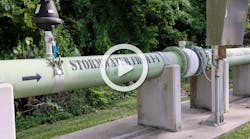Filter Technology is Looking Up
Many developers and municipalities have invested in filtering systems to meet regulatory requirements for treating storm water runoff before it enters waterways. The most common way of filtering such flows is by radial-flow or down-flow surface filtration.
Surface filtration is typically synonymous with down-flow filtration, which uses gravity to draw water down through a filter that traps the substances wished to be captured—similar to the process of making coffee. Surface filtration technologies have been used to treat storm water for decades, and they have been shown to do the job in many instances.
Surface filtration devices, how- ever, have their issues. The capital investment in these immense systems—sometimes large enough to span whole football fields—is tremendous, and regular maintenance can be cost-prohibitive for private developers and small to mid-sized municipalities. As particles, particularly large ones, are captured on the surface of the filter, they substantially reduce the surface area available for liquid flow. Thus, surface filters for storm water treatment have been developed with large footprints to try to increase the time between maintenance, but a larger filter surface area substantially increases the capital and lifetime maintenance costs of the filter.
Bogged Down by Maintenance
Regular upkeep is a necessity to ensure a filtration system’s continuous operation. If a system becomes clogged, excess water flow is routed around the filtration device and discharged without treatment. However, the time and costs involved with maintenance are alarming for down-flow filters. Having a system the size of a baseball field, for example, could require removal and replacement of the top 1 to 3 in. of filter sand three to four times a year. This material, in many instances, must be disposed of as hazardous waste.
Another disadvantage of surface filters is that the filter media can remain submerged in water for hours after a storm, providing an environment that promotes bacterial growth and re-release of captured nutrients.
Surface filters often do not offer a high enough flow rate to economically treat storm water. Typical surface filters provide a flow rate of approximately 2 to 5 gal per minute (gpm) per square foot of a surface area. This works well for filtering drinking water since, unlike storm water runoff, flow rates are controlled and usually very high.
Researchers studying down-flow filtration have also voiced concerns about a reduction in filter performance in areas with highly variable amounts of runoff. This is because intermittent filtration can cause the filter media to partially dry out and lessen flow rates and capacities.
A New Approach
Today there is an alternative that is gaining acceptance. New storm water filters employing upflow technology have been found to provide an effective and economical way to capture sediment, metals, oil and bacteria. These devices filter water through an upflow filtration system, capturing pollutants and allowing water to drain out of the media between storm events.
Large particles do not get trapped in the filter; they fall away into a pre-settling chamber so that the full filter surface area remains available. Keeping captured particles away from the filter ensures longer life of the device and the filter media. This design vastly increases the flow rate to an average 15 to 25 gpm per square foot of treatment surface area.
Upflow systems also can reduce the time and costs associated with maintenance. Maintenance of upflow systems typically is required once a year. In addition, some upflow systems are designed with filters that are modular in configuration. These compartmentalized filter beds literally can be flipped open, taken out and replaced with clean ones. Since these modules are lightweight, they do not require a crane or other heavy lifting equipment for removal and maintenance.
An upflow filter is essentially a system that pushes water upward and allows particles to fall away separately from the filter. A true upflow system leaves room for the filter media to swell and circulate through the device, and this added room ensures a higher flow-through capacity.
With upflow systems, communities gain several important advantages in tackling pollution. Because the footprint of upflow filtration systems is much smaller than that of traditional down-flow systems, a community has the option to install several small upflow filters at pollution hot spots or in areas near sensitive watersheds. The large size of traditional down-flow filters means installation is only feasible at the downstream side of storm water collection systems. Because of its location, the filter must treat all flows, regardless of how high their pollution levels.
Alternatively, more compact upstream filters can be installed at several inlet catch basins at the actual pollution source. This is particularly useful in catching toxic contaminants such as oil dripping from idling vehicles or pesticides used at corporate farms and commercial nurseries.
Furthermore, a properly designed upflow system will prevent upstream flooding by incorporating high-flow bypass mechanisms which ensure that during large storms, any excess water is discharged properly.
Upflow Application
A good example of upflow technology at work can be found, ironically, in New Zealand, the “Land Down Under.” In recent years, a developer needed to address runoff conditions to gain approval for a marina expansion along the environmentally sensitive Hauraki Gulf near the city of Auckland. The region experiences a high level of rainfall—about 4 ft per year.
In order to successfully treat the pollutant-ridden runoff from an onsite parking area, Orekei Marina Development could have utilized a surface filtration system. The slow filtration rate, though, would have required the use of a much larger system, significantly increasing project costs.
The developer used three Hydro Intl. Up-Flo filters supplied by the company’s New Zealand distributor, Hynds Environmental. The filter units treat the runoff from 3 acres of parking lots. The relatively low headloss of the filters enabled their installation within the site’s shallow drainage system.
Orekei was able to exceed the community’s requirements for storm water treatment of 75 percent total suspended solids. The system removes more than 90 percent of particles, with a mean particle distribution of 20 microns.
Developers and municipalities have a new tool to curb one of the leading causes of water contamination. Upflow filter systems free users of burdensome maintenance costs and tremendous up-front capital expenses. For the first time, communities can stem harmful storm water pollutants in a more sustain-able, cost-effective manner.
Download: Here

